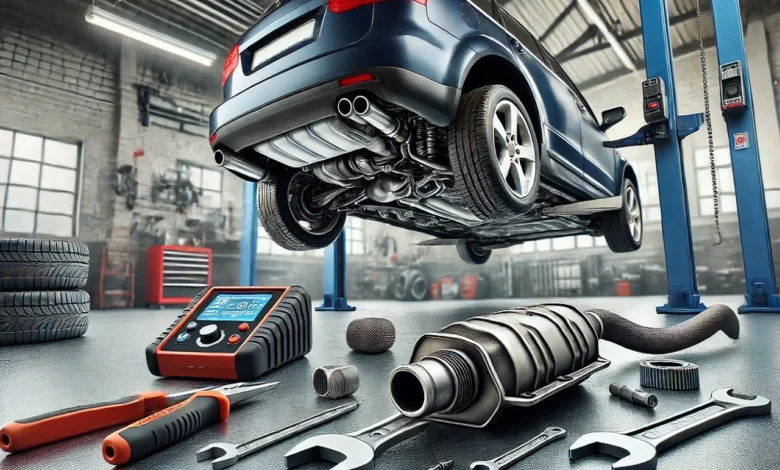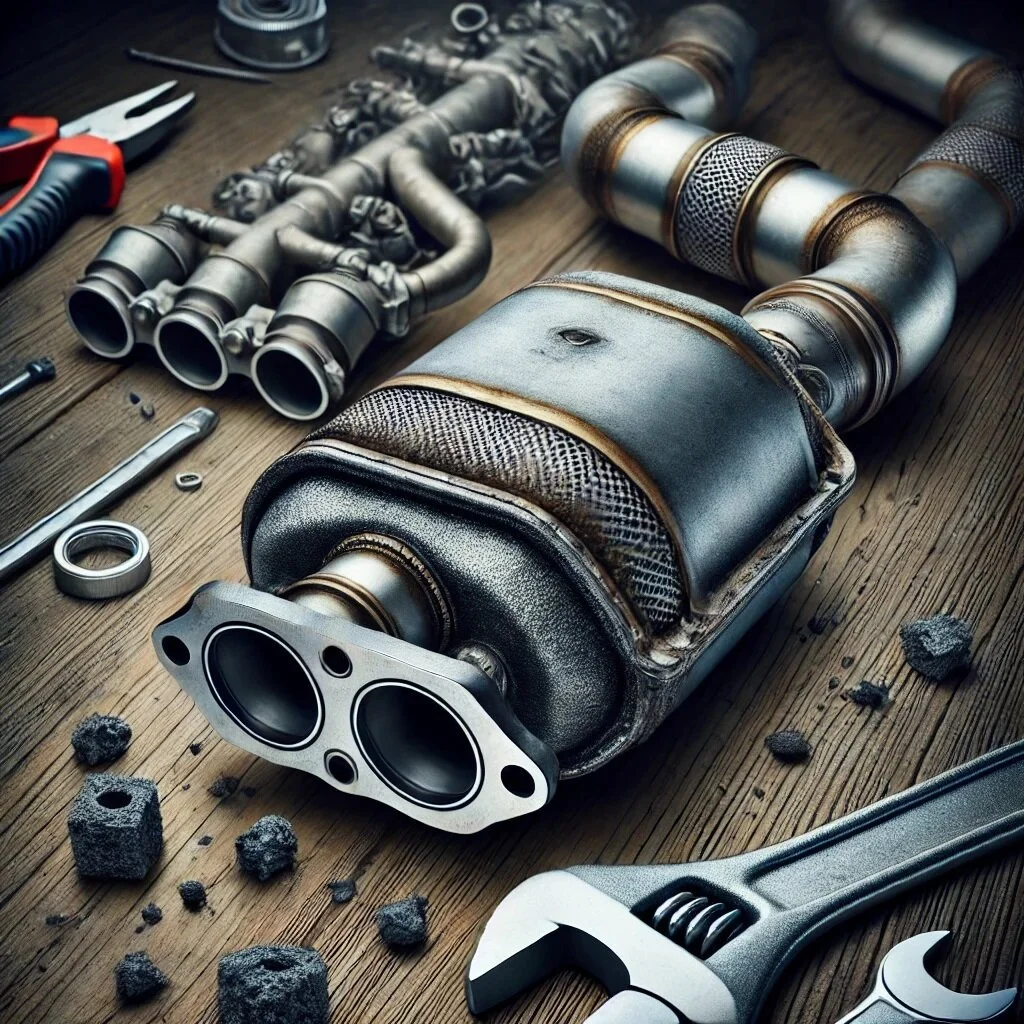
A clogged catalytic converter is no joke. It can cause serious damage to your car’s exhaust system, reduce engine performance, and leave your vehicle non-compliant with emissions regulations. Worse yet, it’s terrible for the environment, releasing harmful gases that a functioning converter would filter out. Ignoring the problem could cost you big—both financially and environmentally. But don’t worry, I’m here to help you figure out how to handle this issue before it becomes a disaster.
Understanding the Role of a Catalytic Converter
Before diving into solutions, let’s understand what a catalytic converter does. It’s part of your car’s emission system, and its job is to reduce the harmful pollutants your engine produces. The converter transforms gases like carbon monoxide and nitrogen oxides into less harmful compounds, making your car more eco-friendly. Inside, it’s filled with a honeycomb structure made from ceramic, coated with precious metals like platinum, palladium, and rhodium. These metals are catalysts, helping chemical reactions that turn bad fumes into better ones.
How Does a Catalytic Converter Get Clogged?
Catalytic converters can get clogged due to several reasons:
- Carbon Buildup: This happens when your engine burns fuel inefficiently, and the unburned fuel forms carbon deposits inside the converter.
- Oil or Coolant Leaks: Leaking oil or coolant can enter the exhaust system and block the honeycomb structure inside the converter.
- Engine Misfires: Misfires cause unburned fuel to flow into the converter, leading to blockages.
- Age and Wear: Over time, the converter can get clogged just from normal wear and tear.
Now that we know what’s going on, let’s figure out if your catalytic converter is the culprit for your car’s performance issues.
Signs and Symptoms of a Clogged Catalytic Converter
You might be wondering, “How do I know if my catalytic converter is clogged?” The symptoms can be subtle or obvious, depending on the severity of the problem. Here’s what to watch for:
- Poor Acceleration: If your car hesitates when you press the gas pedal, it could be due to increased backpressure in the exhaust system caused by a clogged converter.
- Reduced Fuel Efficiency: Are you spending more at the pump than usual? A clogged catalytic converter makes your engine work harder, leading to lower fuel efficiency.
- Check Engine Light: This light can indicate various issues, but one of the common reasons is a clogged or failing catalytic converter. Get an OBD scan to confirm the issue.
- Rotten Egg Smell: A clogged converter can cause sulfur buildup, leading to a strong rotten egg odor from your exhaust.
- Rattling Noises: If you hear a rattling sound under your car, it might mean that the internal components of the catalytic converter are damaged or clogged.
How to Test for a Clogged Catalytic Converter
Testing for a clogged catalytic converter is crucial before you jump to conclusions. Here are some easy ways to diagnose the issue:
- Vacuum Test: This simple test can help determine if there’s restricted airflow. Connect a vacuum gauge to the intake manifold. If the gauge reading drops significantly while revving the engine, your catalytic converter might be clogged.
- Temperature Test: Using an infrared thermometer, check the temperature before and after the catalytic converter. A healthy converter should be hotter on the output side. If both sides are the same or the input side is hotter, it’s likely clogged.
- Exhaust Pressure Test: This involves using a pressure gauge at the oxygen sensor port. High backpressure readings usually indicate a clog.
How to Unclog a Catalytic Converter Without Removing It
So, you’ve figured out that your catalytic converter is clogged. Now, let’s talk about how to fix it without taking the whole thing apart.
Using Catalytic Converter Cleaner
One of the easiest ways to tackle a clogged catalytic converter is by using a cleaner. This method works best when the clog isn’t too severe. Here’s what you need to do:
- Drive until your gas tank is about one-quarter full. This allows the cleaner to work more effectively.
- Add a catalytic converter cleaner to your gas tank. Make sure it’s compatible with your vehicle’s fuel type.
- Drive for at least 15-30 minutes at highway speeds to allow the cleaner to circulate through the system and break down the carbon deposits.
- Refill your tank with fresh fuel after driving.
While cleaners are not guaranteed to fix severe clogs, they’re a good first step and are cost-effective. It’s also a preventive measure to use them every 5,000 miles.
DIY Methods to Clean a Catalytic Converter at Home

If the cleaner doesn’t work, don’t panic. You can try these more hands-on methods. Let’s get into the details:
Pressure Washing Method
If the clog is severe, you might need to remove the catalytic converter and give it a good clean.
- Remove the Converter: Jack up your vehicle and safely remove the catalytic converter from the exhaust system.
- Pressure Wash the Converter: Use a pressure washer on the lowest setting to spray both ends of the converter. This will help to break down and remove debris.
- Let it Dry: Once cleaned, allow the converter to dry completely before reinstalling it. This might take a few hours.
Soaking Method
If the pressure wash isn’t enough, soaking the catalytic converter can help remove stubborn deposits.
- Fill a Bucket with Soapy Water: Use hot water and dish soap in a large bucket that can fit the converter.
- Soak the Converter Overnight: Let it soak for several hours or overnight.
- Rinse and Dry: Rinse the converter with a hose or low-pressure washer, then let it dry completely.
When Cleaning Doesn’t Work: Signs You Need a Replacement
If you’ve tried the above methods and your car is still sluggish, it might be time to replace the catalytic converter. Here are signs that cleaning won’t be enough:
- Persistent Check Engine Light: If the light stays on even after cleaning, the converter might be too far gone.
- Rattling Noises: Damaged internal components like the honeycomb can’t be fixed by cleaning.
- Emission Test Failures: If you’ve failed an emissions test, cleaning may not restore the converter’s function.
It’s important to note that driving with a faulty or removed catalytic converter can result in legal penalties and more harm to your engine.
Preventing Future Clogs
Now that you’ve dealt with your catalytic converter, let’s talk about prevention.
- Maintain Your Engine: Keeping your engine in good shape helps prevent excess carbon buildup. Address any misfires, leaky fuel injectors, or oil leaks immediately.
- Use High-Quality Fuel: Poor-quality fuel can contribute to clogs over time. Stick to reputable gas stations and consider using fuel additives every few thousand miles.
- Solve Underlying Issues: If your converter got clogged because of a misfire or leaky injectors, fix those issues first, or you’ll be right back where you started.
Environmental Impact of a Clogged Catalytic Converter
Driving with a clogged or failing catalytic converter doesn’t just hurt your engine; it also contributes to air pollution. A blocked converter releases harmful gases like nitrogen oxides and carbon monoxide into the atmosphere, failing its role as an emissions filter. This not only impacts air quality but also increases your carbon footprint. Regular maintenance is key to keeping your vehicle eco-friendly and compliant with environmental regulations.
Conclusion
A clogged catalytic converter is a problem you can’t afford to ignore. It impacts everything from your car’s performance to your wallet, and even the environment. Whether you’re using a cleaner, pressure washing it, or soaking the converter, addressing the clog sooner rather than later is the best way to avoid costly repairs or replacements. Keep an eye out for the symptoms and act fast when your catalytic converter starts showing signs of trouble. Regular maintenance and preventive measures will help keep your converter clean and your car running smoothly for years to come.
We hope you found this article helpful. If you did, be sure to check out our blog for more great content like this.





